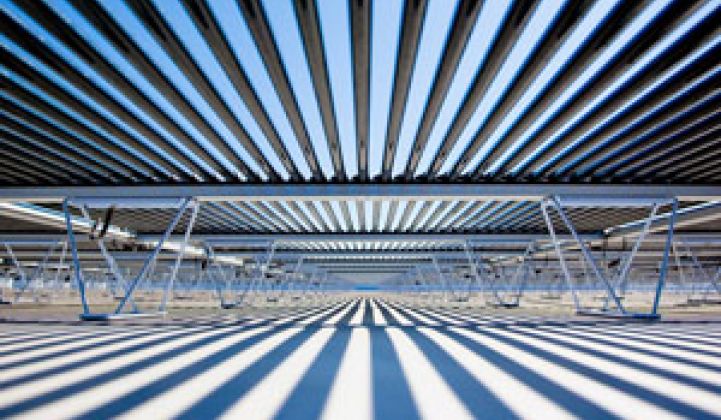Eight months after it started shipping solar panels from its first factory, Solyndra has been able to boost the average power output of its panels from 157 watts to "close to 200 watts."
Making that gain is a key reason why Solyndra has revised what it expects would be the production capacity of its second, 500-megawatt manufacturing plant, which it hopes to start building by the end of the year, said Kelly Truman, vice president of marketing, sales and business development, on Tuesday.
"It's not because we are adding more equipment, but because we are putting out panels at a better yield than we expected already," Truman said. The Fremont, Calif.-based company previously had pegged the capacity of the new factory at 420 megawatts per year.
Solyndra, founded in 2005, has just won a federal $535 million loan guarantee that would allow it to borrow money from the government for building that second factory. The U.S. Department Energy announced the loan guarantee last Friday and touted it as proof that it was acting quickly to dole out federal dollars to create jobs and do good for the environment at the same time (see Solyndra Secures $535M in Federal Loan Guarantees).
The hefty loan is coming at a good time for Solyndra. Raising money from private sources has been tough for just about anyone with a big-budget project. The loan would make up 73 percent of the factory project costs. Truman is mum about whether the company already has raised the rest, saying "I can't comment on future fundraising."
Taking out a large loan also has its risks. Martin Roscheisen, CEO of Nanosolar, a competitor of Solyndra, said a young company that takes on this much debt could raise concerns among current and potential customers.
"The new, post-2008 world is a deleveraged one where it's balance sheet strength that rules. Especially in solar, a 25-year warranty industry, it is critical for a manufacturer's customers to be able to bank on your balance sheet," Roscheisen said via email. "Taking on a lot of debt, and at very early stage, is incongruent with this. At Nanosolar, we have a very strong cash position and are debt free. We are planning to add some leverage as we grow but cautiously so."
The startup has come up with an unusual design for its solar panels. Instead of stringing together solar cells on a flat surface, Solyndra lines them in glass tubes. The copper-indium-gallium-diselenide (CIGS) cells are deposited on the outer surface of an inner tube and covered with another compound that concentrates the sunlight as it hits the cells, said Solyndra CEO Chris Gronet during an interview last October (see Solyndra Rolls out Tube-Shaped Thin Film). Gronet declined to say more about the compound, which would boost the solar cells' power production.
Solyndra said the tubular design make the solar cells to work harder because they can capture not only direct sunlight but also diffused and reflected light. The company places 40 of the cylinders side by side in a rectangular frame to form each 1-meter-by-2-meter panel. Most of the other solar panels on the market today are lined with solar cells that only face the sun.
Truman said the company's solar cells, when rolled flat, can convert close to 14 percent of the sunlight that hits them into electricity. That efficiency is higher than some of its competitors but not as good the best crystalline silicon cells on the market. But efficiency isn't as critical as the power output of the cells when they are rolled up inside the tubes, he said.
Solyndra, which is targeting the commercial rooftop market, is no longer collecting panel performance data from systems the company and its customers use to test the equipment. The company's panels are in commercial installations in the United States, Germany, Spain and France, Truman said. There is a completed, 135-kilowatt system in Livermore, Calif. Another 480-kilowatt system is in Spain. Installers in Germany are installing a 100-kilowatt system and a 400-kilowatt system, Truman added.
The startup currently has a 110-megawatt factory, although it hasn't disclosed its production volume. Last October, Gronet said the company was still revving up its production at the factory.
The second factory would help Solyndra fulfill the sales contracts it has signed. The company already has announced at least $1.52 billion, multiyear agreements with customers in the United States and Europe (see Solyndra Snags $320M Deal with Roofing Firm and Solyndra Signs $250M GeckoLogic Deal).
The new factory would have six production lines, and Solyndra plans to install them in phases. The company would like to start shipping panels commercially in early 2011, Truman said.
Join industry leaders and influencers at Surviving the Shakeout: Greentech Media’s 2009 Solar Industry Summit in Phoenix, Ariz., April 14–15.




